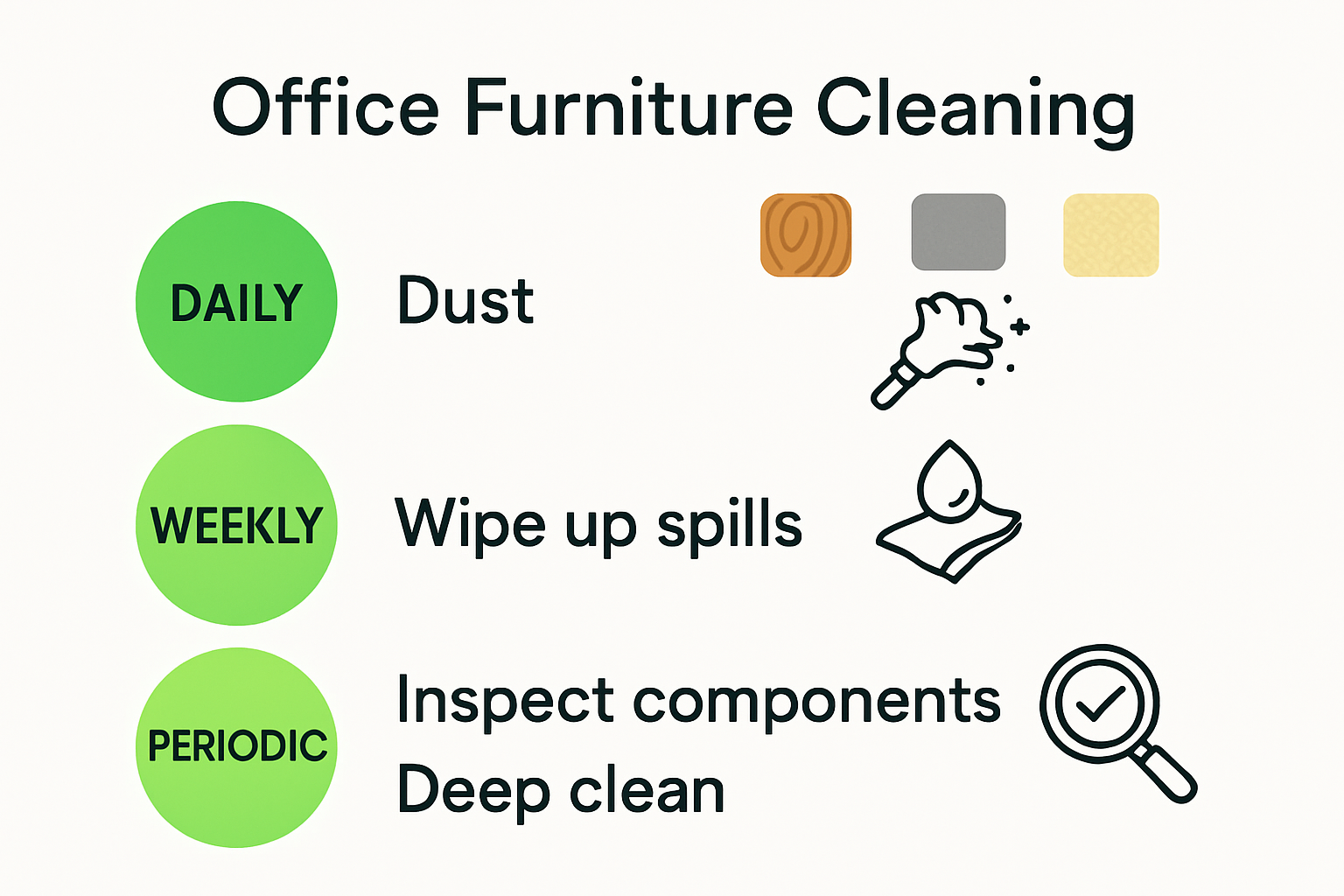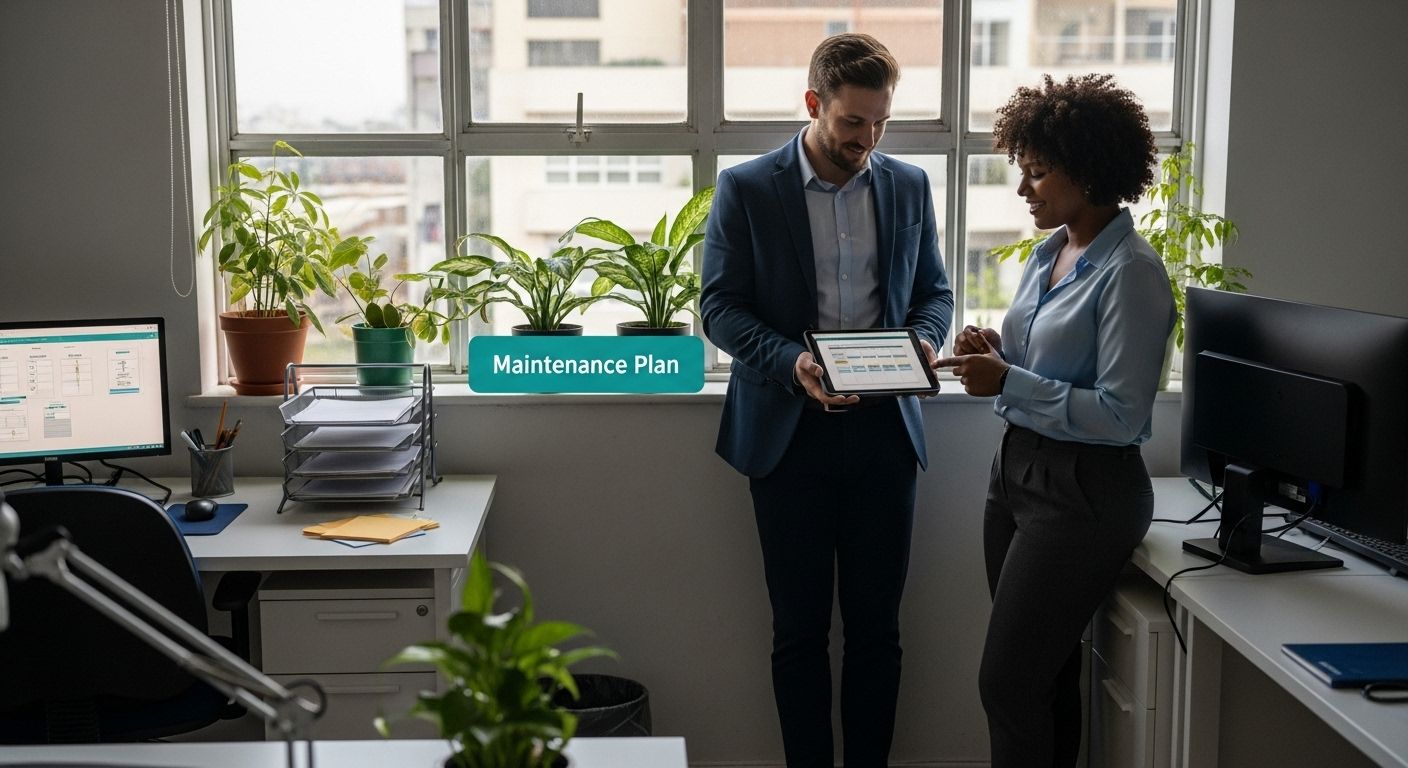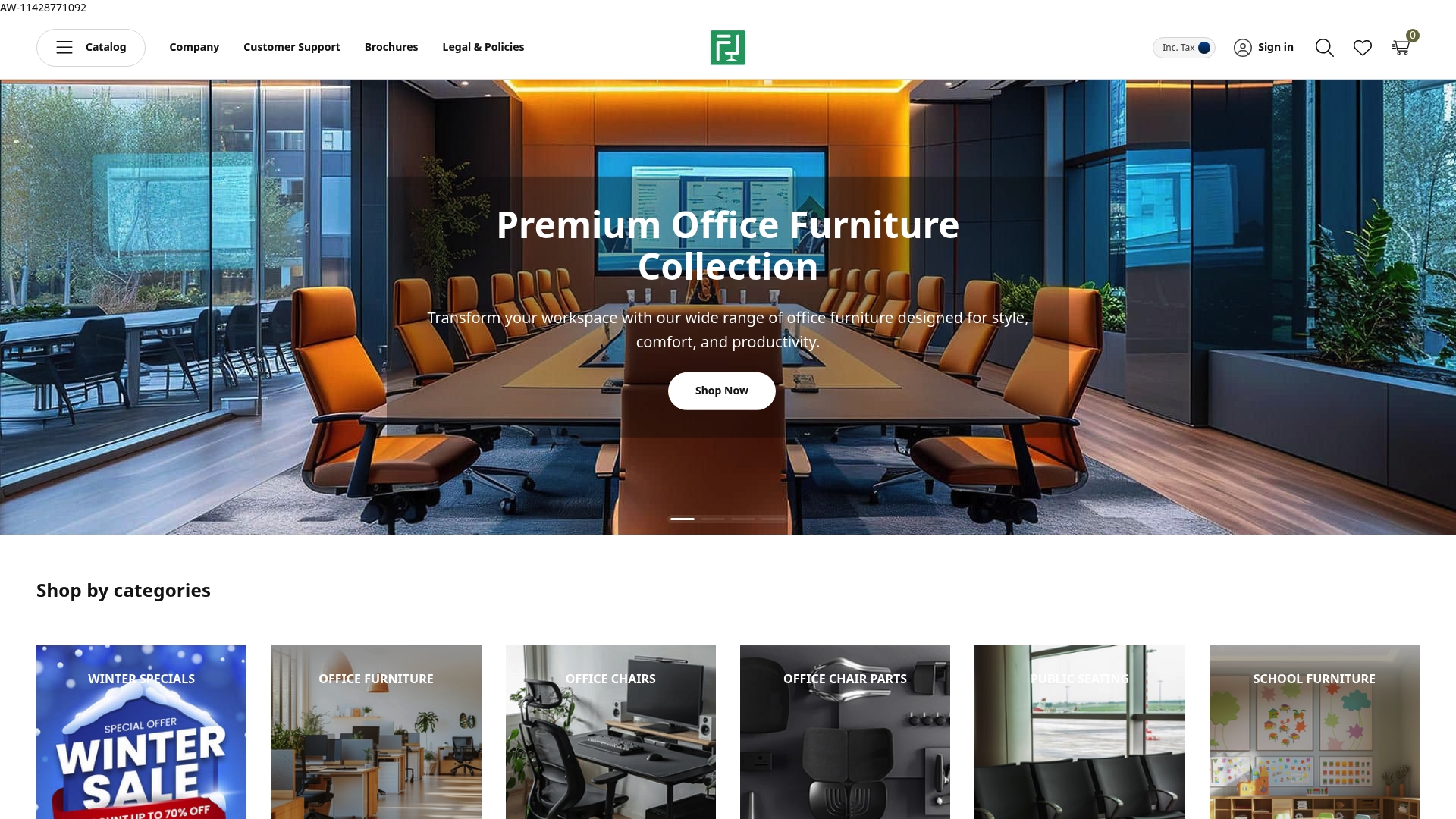Office Furniture Maintenance Guide 2025 for Southern Africa
Jul 31, 2025
Office Furniture Maintenance Guide 2025 for Southern Africa

Everyone wants their office to look sharp and run smoothly. Most people think a decent chair or a sturdy desk will last for years on its own, but did you know proper furniture care can actually make your office gear last up to 40 percent longer? Spending a little time on maintenance is not only about keeping things clean. It is a smart way for Southern African businesses to save cash and keep their workplaces looking professional—without shelling out for replacements every few years.
Table of Contents
- Understanding Office Furniture Maintenance Needs
- Essential Cleaning and Care Procedures
- Repair Strategies for Common Furniture Issues
- Creating a Maintenance Plan for Your Business
Quick Summary
| Takeaway | Explanation |
|---|---|
| Prioritize preventive maintenance strategies | Implementing routine inspections and repairs can extend furniture lifespan and lower replacement costs. |
| Adopt material-specific care techniques | Use tailored cleaning methods for different materials to ensure effective preservation without damage. |
| Establish a systematic maintenance plan | A comprehensive plan outlines goals, budgeting, and tracking for effective furniture upkeep. |
| Train employees on basic maintenance | Educating staff on proper care prevents damage and prolongs furniture lifespan. |
| Consider professional cleaning services | Regular deep cleaning by professionals can help maintain a pristine workplace environment and address hard-to-reach areas. |
Understanding Office Furniture Maintenance Needs
Maintaining office furniture is more than a routine task—it’s a strategic investment in your workplace’s efficiency, aesthetics, and long-term financial health. In Southern Africa’s dynamic business environment, understanding the nuanced approach to office furniture maintenance can significantly impact an organization’s operational productivity and workspace sustainability.
The Economic Impact of Proper Furniture Care
Professional furniture maintenance goes beyond simple cleaning. According to Standard furniture manufacturers, regular maintenance can extend furniture lifespan by up to 40%, reducing replacement costs and minimizing workplace disruptions. In the context of Southern African businesses, where office equipment represents a substantial capital investment, this approach translates into significant economic advantages.
Environmental factors play a crucial role in furniture degradation. Research on furniture conservation highlights that uncontrolled temperature, humidity, and light exposure can cause permanent damage to office furniture materials. For Southern African businesses operating in diverse climatic conditions—from coastal regions to inland areas with extreme temperature variations—understanding these environmental challenges becomes paramount.
Material-Specific Maintenance Strategies
Different office furniture materials demand unique maintenance approaches. Wooden furniture requires gentle cleaning with specific products that preserve its finish, while metal components need protection against corrosion, particularly in coastal or high-humidity environments. School furniture maintenance experts recommend using material-specific cleaning agents and avoiding harsh chemicals that can compromise furniture integrity.
Ergonomic office chairs, which represent a significant investment for many organizations, need specialized care. Regular inspection of mechanical components, lubrication of moving parts, and careful cleaning of upholstery can prevent premature wear and maintain employee comfort. Learn more about choosing quality office furniture.
Preventive Maintenance: A Cost-Effective Approach
Preventive maintenance is the cornerstone of intelligent office furniture management. This approach involves routine inspections, immediate repair of minor damages, and implementing protective measures. By addressing potential issues before they escalate, businesses can avoid costly replacements and maintain a professional workspace appearance.
Implementing a structured maintenance schedule that includes weekly cleaning, quarterly detailed inspections, and annual comprehensive assessments can dramatically reduce long-term maintenance expenses. Training staff on proper furniture handling and creating clear maintenance guidelines further supports this strategic approach.
For Southern African businesses, investing time and resources in understanding and implementing comprehensive office furniture maintenance is not just about preserving physical assets—it’s about creating a productive, professional, and sustainable work environment that reflects organizational excellence.
To help clarify the unique requirements of different furniture materials, the following table summarises recommended maintenance and cleaning strategies for each type:
| Material | Cleaning Approach | Maintenance Tips |
|---|---|---|
| Wood | Wood-specific cleaner | Avoid excess moisture; polish periodically |
| Metal | Non-abrasive cleaner | Protect from corrosion; regular inspection |
| Upholstered (fabric) | Vacuum, fabric cleaner | Address spills immediately; regular vacuuming |
| Leather | pH-neutral conditioner | Condition regularly; avoid direct sunlight |
| Ergonomic chair mechanics | Damp cloth, lube | Lubricate moving parts; regular inspection |
Essential Cleaning and Care Procedures

Maintaining a clean and well-preserved office environment requires systematic and strategic cleaning procedures that protect both furniture investments and employee health. For Southern African businesses, implementing comprehensive cleaning protocols is crucial for prolonging furniture lifespan and creating professional workspace conditions.
Daily and Weekly Cleaning Protocols
Consistent cleaning practices form the foundation of effective office furniture maintenance. CDC’s National Institute for Occupational Safety and Health recommends establishing structured cleaning routines that address different surface materials and potential contaminants.
Daily tasks should include:
- Surface dusting using microfiber cloths to prevent particle accumulation
- Immediate spill management to prevent staining and material degradation
- Quick wipe-downs of high-touch areas like desk surfaces and chair armrests
Weekly procedures involve more comprehensive cleaning approaches. This includes thorough surface sanitization, detailed upholstery maintenance, and inspection of furniture components for early signs of wear or damage. Using cleaning agents specifically designed for different materials ensures optimal preservation without causing unintended surface deterioration.
To make cleaning schedules easier to follow, here’s a table outlining suggested daily and weekly office furniture cleaning tasks:
| Task | Frequency | Description |
|---|---|---|
| Surface dusting | Daily | Use microfiber cloths to remove dust |
| Spill management | Daily | Clean spills promptly to avoid stains |
| Wipe high-touch areas | Daily | Disinfect chair arms, desk surfaces |
| Surface sanitisation | Weekly | Thorough cleaning with appropriate agents |
| Upholstery vacuuming | Weekly | Remove debris from fabric/chairs |
| Inspect components | Weekly | Check for damage or wear |
Material-Specific Cleaning Techniques
Each office furniture material demands specialized cleaning approaches. Occupational Safety and Health Administration guidelines emphasize the importance of using appropriate cleaning techniques that maintain surface integrity while ensuring workplace hygiene.
For wooden furniture, use gentle wood-specific cleaners that nourish and protect the surface. Avoid saturating wooden surfaces, as excess moisture can cause warping or structural damage. Metal components require non-abrasive cleaners that prevent corrosion and maintain their finish, particularly important in Southern Africa’s varied climate conditions.
Fabric and upholstered surfaces need careful attention. Regular vacuuming prevents dust and debris accumulation, while specialized fabric cleaners help maintain appearance and prevent permanent staining. For leather surfaces, use pH-neutral leather conditioning products that prevent cracking and maintain material suppleness.
Professional Maintenance and Deep Cleaning
Beyond routine cleaning, periodic professional maintenance is essential for comprehensive office furniture care. Quarterly or biannual deep cleaning sessions conducted by professional services can address hard-to-reach areas, perform detailed inspections, and apply protective treatments.
Professional maintenance typically includes:
- Comprehensive surface restoration
- Mechanical component lubrication
- Fabric and upholstery deep cleaning
- Protective coating applications
Additionally, explore our office furniture care solutions to understand how professional maintenance can extend your furniture’s lifespan and maintain a pristine workplace environment.
By implementing these systematic cleaning and care procedures, Southern African businesses can protect their furniture investments, create healthier work environments, and project a professional image that reflects organizational excellence and attention to detail.
Repair Strategies for Common Furniture Issues
Office furniture encounters numerous challenges that can compromise its functionality and aesthetic appeal. Understanding and addressing these issues promptly can significantly extend furniture lifespan and maintain workplace productivity. Southern African businesses must develop proactive repair strategies to manage common furniture problems effectively.
Structural Integrity and Stability Challenges
Preservation experts from the National Park Service emphasize the importance of addressing structural issues before they escalate. In office environments, common structural problems include wobbly chair bases, loose desk joints, and weakening furniture frames.
Identifying early signs of structural weakness requires careful inspection. Look for:
- Visible joint separation
- Unexpected movement when pressure is applied
- Creaking or unusual sounds during use
- Uneven surfaces or misalignment
Immediate intervention involves professional assessment and targeted repair techniques. For wooden furniture, this might include regluing joints, replacing worn connectors, or reinforcing critical stress points. Metal furniture may require welding, precise realignment, or component replacement.
Surface Damage and Restoration Techniques
Surface damage represents another critical maintenance challenge for office furniture. Different materials demand specialized repair approaches that preserve both functionality and aesthetic quality.
Wooden surfaces often experience scratches, dents, and finish deterioration. Minor scratches can be addressed using wood repair markers or wax-based fillers that match the original finish. Deeper damages might require professional sanding, refinishing, or strategic veneer replacement.
Upholstered furniture presents unique repair challenges. Tears, stains, and fabric wear can significantly impact appearance and comfort. Professional reupholstering or targeted patch repairs can restore furniture to near-original condition. For leather surfaces, specialized leather repair kits can effectively manage small punctures and wear points.
Mechanical Component Restoration
Ergonomic office furniture with mechanical components—such as adjustable chairs and height-adaptive desks—requires specialized maintenance. These intricate systems demand precise repair strategies to maintain optimal functionality.
Common mechanical issues include:
- Hydraulic lift mechanism failures
- Broken adjustment levers
- Seized or stiff movement mechanisms
Resolving these issues often requires professional intervention. Replacement of specific mechanical parts, recalibration of adjustment systems, and lubrication of moving components can restore furniture to full operational capacity.
Explore our comprehensive furniture repair solutions to understand how professional maintenance can transform seemingly damaged furniture into fully functional workplace assets.
For Southern African businesses, developing a strategic approach to furniture repair is not merely about fixing individual pieces—it represents a comprehensive asset management strategy that balances cost-effectiveness, workplace aesthetics, and long-term equipment sustainability. Proactive maintenance and timely repairs ensure that office furniture continues to support workplace productivity and professional image.
Creating a Maintenance Plan for Your Business

Developing a comprehensive maintenance plan is essential for Southern African businesses seeking to optimize their office furniture investments and create sustainable workplace environments. A strategic maintenance approach goes beyond reactive repairs, transforming furniture management into a proactive, cost-effective organizational strategy.
Establishing Maintenance Framework and Objectives
The U.S. Environmental Protection Agency recommends developing a structured maintenance plan that encompasses multiple critical components. The primary objectives should include protecting capital investments, maintaining workplace productivity, and extending furniture lifespan.
Key framework components include:
- Clear maintenance goals and performance metrics
- Allocated budget for maintenance activities
- Designated responsible personnel
- Systematic documentation and tracking
- Regular performance evaluation
Successful maintenance planning requires a holistic approach that integrates staff training, resource allocation, and continuous improvement strategies. Businesses must view maintenance not as an expense, but as a strategic investment in workplace efficiency and professional image.
The table below summarises the essential components and objectives when establishing an office furniture maintenance plan:
| Framework Component | Objective |
|---|---|
| Maintenance goals & performance metrics | Track success and guide improvements |
| Budget allocation | Ensure adequate resources for upkeep |
| Responsible personnel | Assign clear maintenance duties |
| Systematic documentation & tracking | Maintain records for accountability |
| Regular performance evaluation | Continually assess and improve results |
Implementing Systematic Inspection and Documentation
The National Center for Educational Statistics highlights the importance of developing a robust work order and inspection system. This involves creating standardized processes for identifying, reporting, and addressing furniture maintenance issues.
Effective documentation should include:
- Detailed furniture inventory with acquisition dates
- Condition assessment records
- Maintenance history for each furniture item
- Repair and replacement cost tracking
- Photographic documentation of wear and damage
Digital maintenance management systems can streamline these processes, providing real-time tracking, automated alerts for scheduled maintenance, and comprehensive reporting capabilities. These tools enable businesses to make data-driven decisions about furniture maintenance and replacement.
Training and Continuous Improvement
Maintenance guidance from the Irish Department of Education emphasizes the critical role of staff training in successful maintenance strategies. Employees should be educated on proper furniture handling, early damage identification, and basic maintenance procedures.
Training programs should cover:
- Proper cleaning techniques
- Identifying potential maintenance issues
- Reporting protocols
- Basic preservation practices
Learn more about our maintenance support services to develop a comprehensive approach tailored to your business needs.
For Southern African businesses, a well-designed maintenance plan represents more than a technical requirement—it is a strategic approach to managing workplace resources. By investing in systematic maintenance, organizations can reduce long-term costs, maintain professional aesthetics, and create work environments that support employee productivity and organizational success.
Frequently Asked Questions
What are the benefits of regular office furniture maintenance?
Regular office furniture maintenance can extend the lifespan of your furniture by up to 40%, reduce replacement costs, and enhance the overall aesthetic and functionality of your workplace.
How can I create a maintenance plan for my office furniture?
To create a maintenance plan, establish clear goals, allocate a budget, designate responsible personnel, implement systematic inspections, and ensure regular documentation and evaluations.
What cleaning techniques should I use for different types of office furniture?
Use wood-specific cleaners for wooden furniture, non-abrasive cleaners for metal, fabric cleaners for upholstery, and pH-neutral conditioners for leather to maintain their integrity and appearance.
When should I consider professional maintenance for my office furniture?
Consider professional maintenance quarterly or biannually, especially for deep cleaning and addressing hard-to-reach areas, as it helps maintain a pristine environment and prolongs the furniture’s lifespan.
Give Your Office Furniture the Lifespan It Deserves
Are you tired of seeing your office furniture start to look outdated or wear out before its time? The article highlighted just how costly neglecting basic maintenance can be. In fact, not having a proactive plan often means you spend more on replacements and repairs in the long run. Every business in South Africa faces the challenge of balancing budgeting with maintaining a polished, productive workspace. Issues like worn upholstery and unstable chairs or desks happen when there is no clear maintenance strategy. If you want peace of mind and lasting value from your office essentials, you need furniture solutions designed for both durability and easy upkeep.

Let Office Stock help you build a workplace that stands the test of time. Explore our range of premium office furniture solutions chosen specifically for low-maintenance care and longevity. If you have not yet established a maintenance routine, start by visiting our customer support and care page for expert advice and tips tailored for the South African climate. Give yourself the advantage of partnering with a supplier who knows how to keep your environment looking fresh and professional. Act now and transform your investment into lasting value at https://officestock.co.za.
Recommended
- Laminating Pouches (A4 - Gloss - 220x310mm - 160 (80+80) Microns - Box 100) | Buy Laminator Consumables Online - Office Stock
- Montego Visitor Office Chair | Buy Office Furniture Online - Office Stock
- Bali Visitor Office Chair | Buy Office Chairs Online - Office Stock
- Double School Desk in Saligna Wood 1000mm Wide | Buy School Furniture Online - Office Stock
